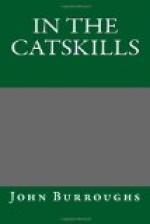It is a singular freak of nature, this instinct which prompts one bird to lay its eggs in the nests of others, and thus shirk the responsibility of rearing its own young. The cow buntings always resort to this cunning trick; and when one reflects upon their numbers, it is evident that these little tragedies are quite frequent. In Europe the parallel case is that of the cuckoo, and occasionally our own cuckoo imposes upon a robin or a thrush in the same manner. The cow bunting seems to have no conscience about the matter, and, so far as I have observed, invariably selects the nest of a bird smaller than itself. Its egg is usually the first to hatch; its young overreaches all the rest when food is brought; it grows with great rapidity, spreads and fills the nest, and the starved and crowded occupants soon perish, when the parent bird removes their dead bodies, giving its whole energy and care to the foster-child.
The warblers and smaller flycatchers are generally the sufferers, though I sometimes see the slate-colored snowbird unconsciously duped in like manner; and the other day, in a tall tree in the woods, I discovered the black-throated green-backed warbler devoting itself to this dusky, overgrown foundling. An old farmer to whom I pointed out the fact was much surprised that such things should happen in his woods without his knowledge.
These birds may be seen prowling through all parts of the woods at this season, watching for an opportunity to steal their egg into some nest. One day while sitting on a log I saw one moving by short flights through the trees and gradually nearing the ground. Its movements were hurried and stealthy. About fifty yards from me it disappeared behind some low brush, and had evidently alighted upon the ground.
After waiting a few moments I cautiously walked in the direction. When about halfway I accidentally made a slight noise, when the bird flew up, and seeing me, hurried off out of the woods. Arrived at the place, I found a simple nest of dry grass and leaves partially concealed under a prostrate branch. I took it to be the nest of a sparrow. There were three eggs in the nest, and one lying about a foot below it as if it had been rolled out, as of course it had. It suggested the thought that perhaps, when the cowbird finds the full complement of eggs in a nest, it throws out one and deposits its own instead. I revisited the nest a few days afterward and found an egg again cast out, but none had been put in its place. The nest had been abandoned by its owner and the eggs were stale.
In all cases where I have found this egg, I have observed both male and female of the cowbird lingering near, the former uttering his peculiar liquid, glassy note from the tops of the trees.
In July, the young which have been reared in the same neighborhood, and which are now of a dull fawn color, begin to collect in small flocks, which grow to be quite large in autumn.




